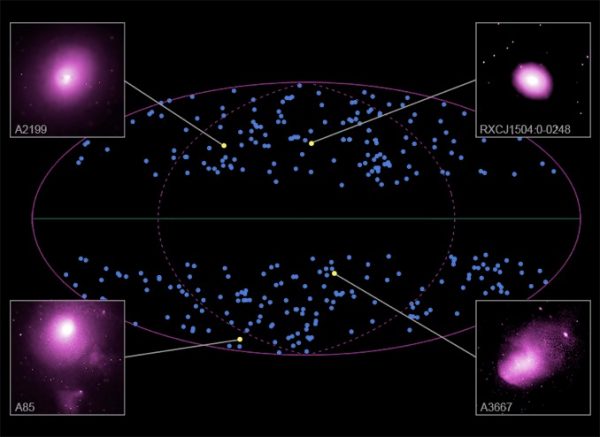The Universe may not look the same in all directions after all – Astronomy Now Online

One of the core assumptions all professional and amateur astronomers learn when first entering the field is that at large scales, the universe appears the same in all directions, that is, it’s isotropic.
A paper accepted for publication in Astronomy and Astrophysics suggests that may not be the case.
An international team of researchers using NASA’s Chandra X-ray Observatory, the European Space Agency’s XMM-Newton and other data archives studied the X-ray luminosity of 842 galaxy clusters.
“If the isotropy hypothesis was correct, the properties of the clusters would be uniform across the sky,” said Konstantinos Migkas, a doctoral student in astronomy and astrophysics at the University of Bonn. “But we actually saw significant differences.”
Said Gerrit Schellenberger of the Harvard-Smithsonian Center for Astrophysics: “Based on our cluster observations we may have found differences in how fast the Universe is expanding depending on which way we looked. This would contradict one of the most basic underlying assumptions we use in cosmology today.”
The team used X-ray observations to measure the temperature of the hot gas that pervades galaxy clusters and then compared that data to how bright the targeted clusters appeared in the sky. Clusters at the same temperature and apparent luminosity would be expected to be equally bright in an isotropic universe.
“We saw that clusters with the same properties, with similar temperatures, appeared to be less bright than what we would expect in one direction of the sky, and brighter than expected in another direction,” said Thomas Reiprich, Migkas’ supervisor. “The difference was quite significant, around 30 per cent. These differences are not random but have a clear pattern depending on the direction in which we observed in the sky.”
The video below, based on observations by the Chandra X-ray Observatory, describes the issue in more detail:
The researchers considered a variety of other possible explanations for the observed differences, including undetected clouds of gas that might affect the light passing through them.
“Since we ignore the possible existence of such clouds, we do not account for their interference, and hence we would falsely underestimate the true luminosity of the clusters,” Migkas wrote in a blog post. “Eventually, we could mistake this for a cosmological effect. We performed several tests that led us to believe that this scenario seems unlikely, but not impossible.”
Two cosmological explanations remain. If the universe is, in fact, anisotropic, one explanation could be that dark energy, the mysterious force accelerating the expansion of the Universe, is stronger in some regions of the cosmos than others. It is also possible that some galaxy clusters are moving faster than expected because of the gravitational influence of other clusters.





